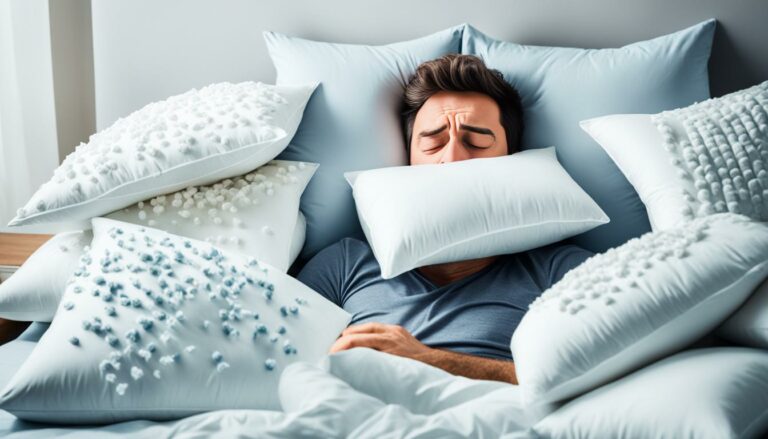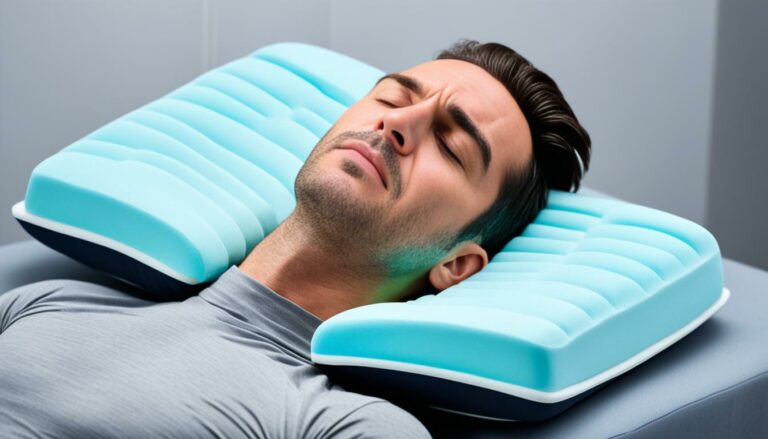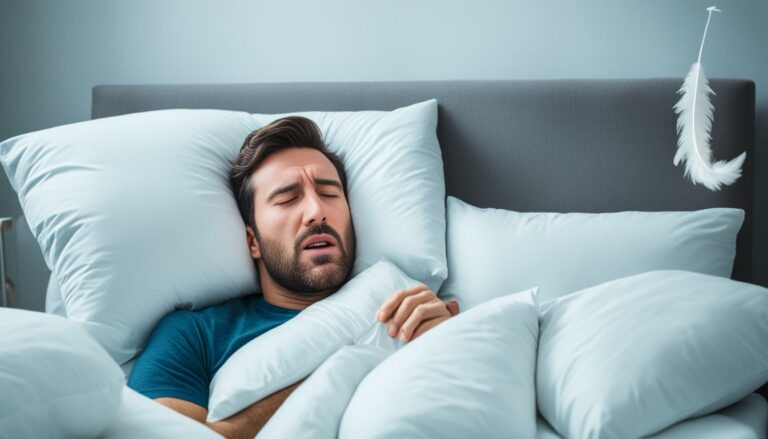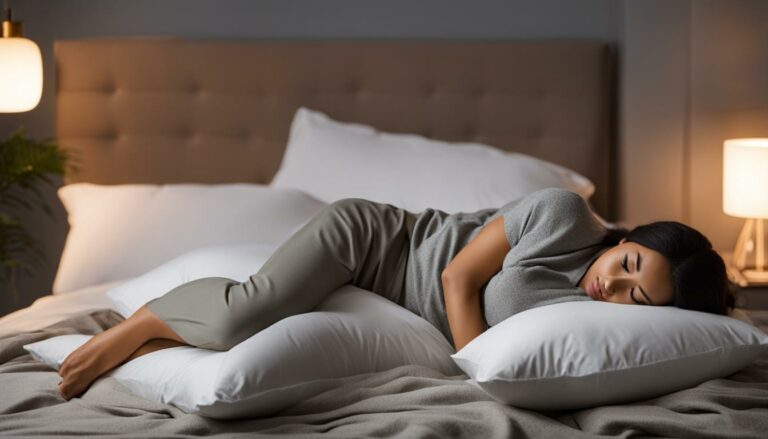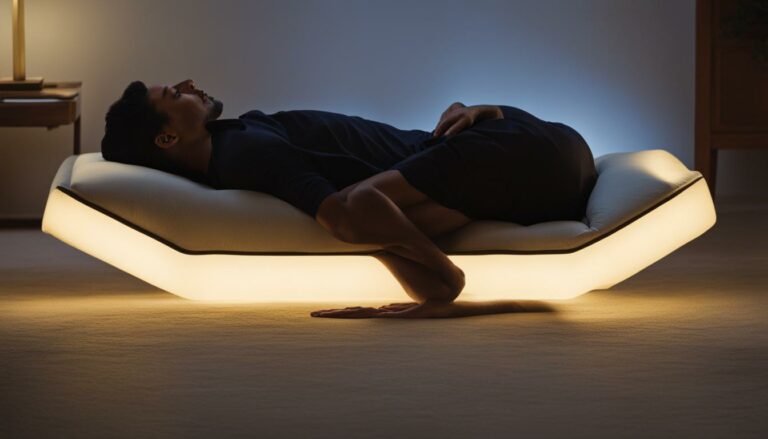Best Pillow Placement for Lower Back Pain Relief
Eric Christie stands as a luminary in the bedding industry, with a career spanning nearly four decades since the early 1980s. His journey through the world of bedding has seen him wear many hats – a manufacturer, designer, and retailer, showcasing his versatility and expertise in Read more...
pillowsandbedsheets.com and its partners may earn a commission if you purchase a product through one of our links
Sleeping positions can have a significant impact on lower back pain. By making simple changes in your sleeping position and using the right pillow placement, you can find relief from lower back pain.
If you suffer from lower back pain, it’s important to know where to put your pillow for optimal support. The right pillow placement can help alleviate discomfort and promote better sleep posture.
In this article, we will explore different sleeping positions and the best ways to position your pillow to find relief from lower back pain. Whether you sleep on your side, back, or stomach, we have tips and recommendations to help you sleep comfortably and wake up pain-free.
Key Takeaways:
- Proper pillow placement can provide relief from lower back pain during sleep.
- Sleeping on your side? Place a pillow between your legs to align your spine and hips.
- Sleeping on your back? Use a pillow under your knees for lower back muscle relaxation.
- Sleeping on your stomach? Place a pillow under your hips and lower stomach to reduce strain.
- Aligning your spine and using pillows for support is essential for reducing lower back pain.
Sleeping on Your Side
If you sleep on your side, there are pillow placement techniques that can help alleviate lower back pain and promote better spinal alignment. One effective method is drawing your legs up slightly toward your chest and placing a pillow between your legs.
This positioning helps align your spine, pelvis, and hips, reducing pressure on your lower back and providing support. By keeping your legs slightly bent and supported, you can maintain a more natural curvature in your lower back, which can alleviate discomfort and promote proper spinal alignment during sleep.
Placing a pillow between your legs also prevents your top leg from pulling down on your spine and causing misalignment. It helps keep your hips level and in line with your shoulders, reducing strain on your lower back.
This pillow placement technique is particularly beneficial for individuals who experience pain or discomfort in their lower back while sleeping on their side. It can help alleviate pressure on the spine and provide relief from lower back pain.
How to use a pillow for lower back pain:
- While lying on your side, draw your legs up slightly toward your chest.
- Place a pillow between your legs, ensuring it supports the entire length from your hip to your ankle.
- Adjust the pillow until you feel comfortable and supported.
| Pillow Placement | Benefits |
|---|---|
| Between your legs |
|
“Sleeping with a pillow between your legs can help align your spine, reduce lower back pain, and promote better sleep quality.” – Dr. Rebecca Thompson
Sleeping on Your Back
If you sleep on your back, you can make pillow placement adjustments to support your lower back and maintain proper spinal alignment. This can help alleviate lower back pain and promote better sleep quality. Here are a few tips to optimize your sleeping position:
- Position a pillow under your knees: Placing a pillow under your knees helps relax your back muscles and maintains the natural curve in your lower back. This position reduces stress on the lumbar spine and promotes a more comfortable sleep.
- Choose a lumbar support pillow: Consider using a lumbar support pillow to provide targeted support to your lower back. These pillows are designed to fit the natural curve of your spine, offering additional comfort and alleviating pressure on your back muscles.
- Support your neck: Along with supporting your lower back, it’s important to properly support your neck while sleeping on your back. Using a pillow that cradles your neck and aligns it with your chest and back can help prevent neck strain and maintain a neutral spine position.
- Experiment with different pillow thickness: The thickness of your pillow can affect the alignment of your head, neck, and spine. Choose a pillow that keeps your head in line with your spine; too high or too low may cause discomfort and strain. It’s a matter of personal preference and finding the pillow that best suits your needs.
| Pillow Positioning Tips for Back Sleepers: |
|---|
By implementing these techniques, you can improve your sleeping posture and reduce the strain on your lower back. Remember that everyone’s needs are different, so it’s essential to find the pillow placement and support that works best for you. Experiment with different pillow types and positions until you find the optimal combination for a restful night’s sleep.
Sleeping on Your Stomach
Sleeping on your stomach can be hard on your back, as it can strain the natural alignment of your spine. However, if this is your preferred sleeping position and you can’t sleep any other way, there are some adjustments you can make to minimize discomfort and reduce the strain on your lower back.
One helpful technique is to place a pillow under your hips and lower stomach. This added support can help maintain a more neutral spinal alignment while sleeping on your stomach. The pillow should be placed beneath your pelvis area, elevating it slightly and reducing the strain on your lower back.
It’s important to note that when using a pillow under your head, it should not place too much strain on your back. Opt for a flatter pillow or even no pillow at all to prevent excessive arching of the neck and further discomfort.
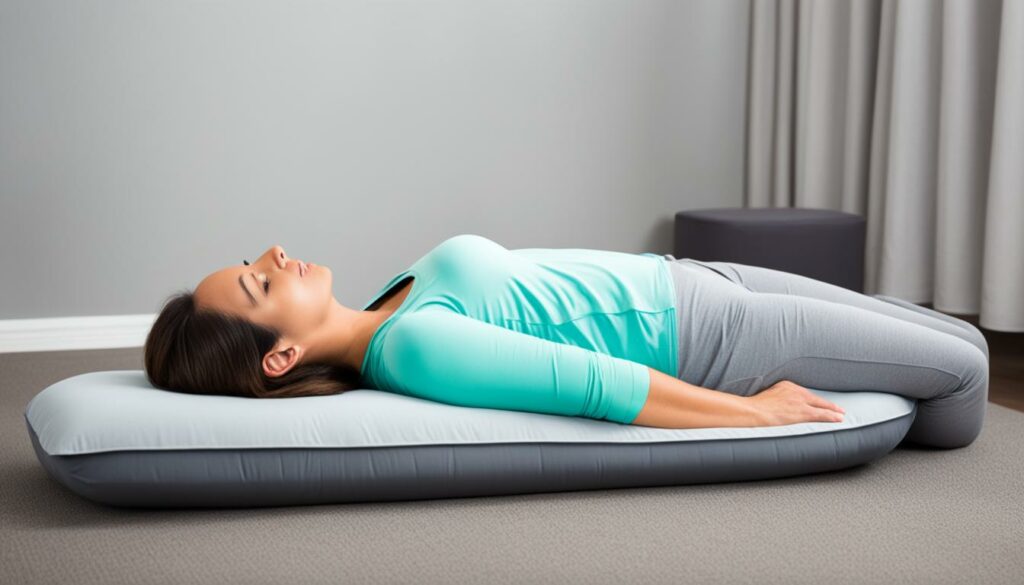
Remember, sleeping on your stomach is generally not the recommended position for individuals with lower back pain. If possible, try to adjust your sleeping position to either your side or back, as these positions offer better support for your spine. However, if sleeping on your stomach is unavoidable, using the right pillow placement can help alleviate some of the strain on your lower back.
The Importance of Alignment
Proper alignment of your spine is crucial for relieving lower back pain. Whether you sleep on your side, back, or stomach, focusing on aligning your ears, shoulders, and hips can reduce stress on your muscles and spine. By using pillows strategically, you can fill any gaps between your body and the bed, providing better support and improving alignment.
Alignment for Side Sleepers
If you are a side sleeper, placing a pillow between your knees helps align your hips and reduces strain on your lower back. This position also helps maintain the natural curvature of your spine. Additionally, using a pillow to support your head and neck keeps your spine in a neutral position, preventing unnecessary strain.
Alignment for Back Sleepers
For back sleepers, adding a pillow under your knees can help relieve pressure on your lower back and promote proper alignment. This position takes stress off the spine and reduces the risk of developing discomfort. Placing a pillow under your neck also supports the natural curve of your spine, encouraging a healthy sleep posture.
Alignment for Stomach Sleepers
While sleeping on your stomach is not ideal for lower back pain, you can improve alignment by placing a pillow under your hips and lower abdomen. This technique helps prevent excessive arching of the back and minimizes strain. It’s essential to use a thin pillow or no pillow at all for your head to avoid straining your neck or back.
Remember, proper alignment is key to relieving lower back pain while you sleep. Utilize pillows strategically to support your body and maintain a neutral spine position. It’s essential to experiment with different pillow placements until you find the combination that works best for your comfort and pain relief.
“Proper alignment of your spine is crucial for relieving lower back pain. By aligning your ears, shoulders, and hips, you can reduce stress on your muscles and spine.”
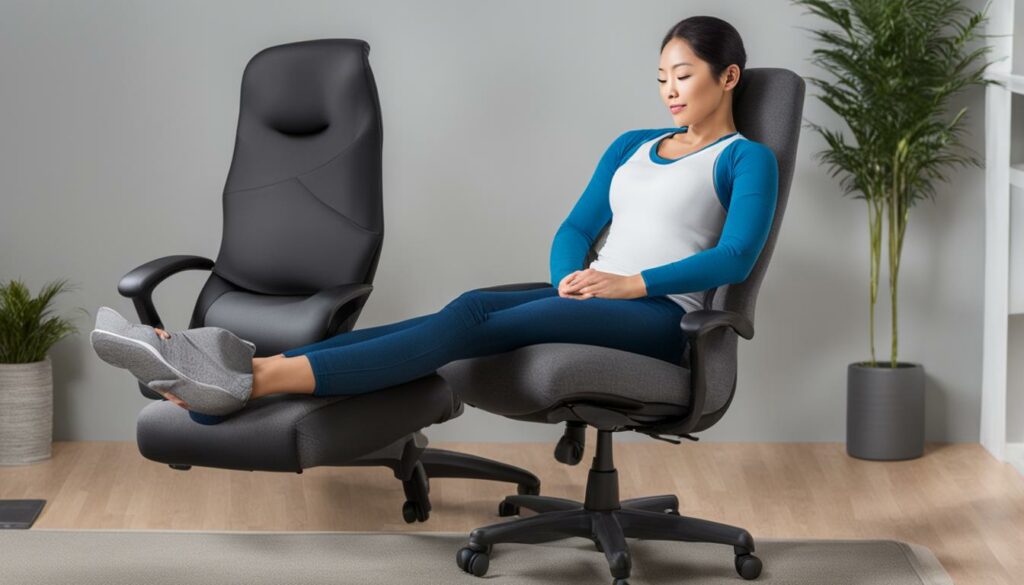
| Sleeping Position | Pillow Placement |
|---|---|
| Side Sleeping | Place a pillow between your knees to align your hips. Use another pillow to support your head and neck. |
| Back Sleeping | Put a pillow under your knees to relieve pressure on your lower back. Use an additional pillow to support your neck. |
| Stomach Sleeping | Place a pillow under your hips and lower abdomen to prevent excessive arching of the back. Use a thin pillow or no pillow for your head. |
Choosing the Right Pillow
Your pillow plays a crucial role in providing lower back pain relief and ensuring a restful night’s sleep. It should cradle your head and neck while offering support to the upper portion of your spine. By selecting the right pillow, you can optimize your sleep posture and alleviate discomfort.
Here are some recommendations for pillow placement based on your preferred sleeping position:
- Back Sleepers: Back sleepers may find thinner pillows with extra padding for neck support ideal. This helps maintain the natural curve of the spine while keeping the neck properly aligned. A pillow designed specifically for back sleepers can offer targeted support for the lower back.
- Side Sleepers: For side sleepers, a firmer pillow that fills the gap between the neck and shoulder is recommended. This promotes proper spinal alignment and reduces strain on the lower back. You may also consider placing a pillow between your knees for additional support and to prevent your top knee from pulling your spine out of alignment.
- Stomach Sleepers: Stomach sleepers should use the thinnest pillow possible or no pillow at all. This position puts strain on the neck and lower back, so minimizing pillow height can help maintain a more neutral spinal alignment. Alternatively, you can try using a thin pillow under your hips to alleviate back strain.
Remember, the goal is to maintain proper alignment of your spine regardless of your sleeping position. Experiment with different pillow types and heights to find the one that offers the most comfort and support for your lower back.
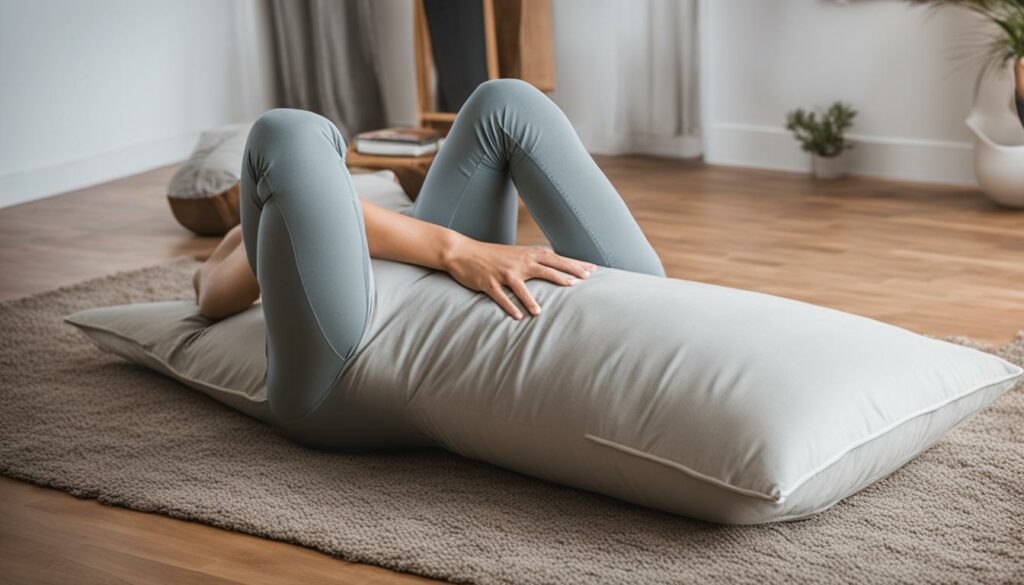
Having a visual representation of the recommended pillows for each sleeping position can be helpful. The table below provides a summary of the pillow recommendations:
| Sleeping Position | Ideal Pillow | Additional Support |
|---|---|---|
| Back Sleepers | Thinner pillow with extra padding for neck support | Consider a pillow designed for back sleepers |
| Side Sleepers | Firmer pillow that fills the gap between neck and shoulder | Use a pillow between the knees |
| Stomach Sleepers | Thinnest pillow possible or no pillow | Try a thin pillow under the hips for additional support |
Remember to consider your personal preferences and comfort level when choosing a pillow. Ultimately, finding the right pillow that suits your needs can greatly contribute to relieving lower back pain and improving the quality of your sleep.
Considering Your Mattress
A suitable mattress can play a significant role in alleviating lower back pain. When choosing a mattress, opt for a medium-firm one that provides a balance of comfort and support. A mattress that is too soft may not offer enough support, while a mattress that is too firm can cause discomfort and increase pressure on your lower back.
If you already have a mattress that is not ideal for your lower back, you can improve the spine’s alignment by adding a memory foam mattress topper. The memory foam conforms to your body shape, providing additional support to your lower back and relieving pressure points.
If possible, it’s always recommended to test out a mattress before purchasing. Take the time to lay down and see how it feels for your lower back. Additionally, if your mattress is too soft or sagging, you can place a plywood board under it to add some firmness and support.
Remember, the right mattress can significantly improve your sleep quality, reduce lower back pain, and contribute to overall well-being.
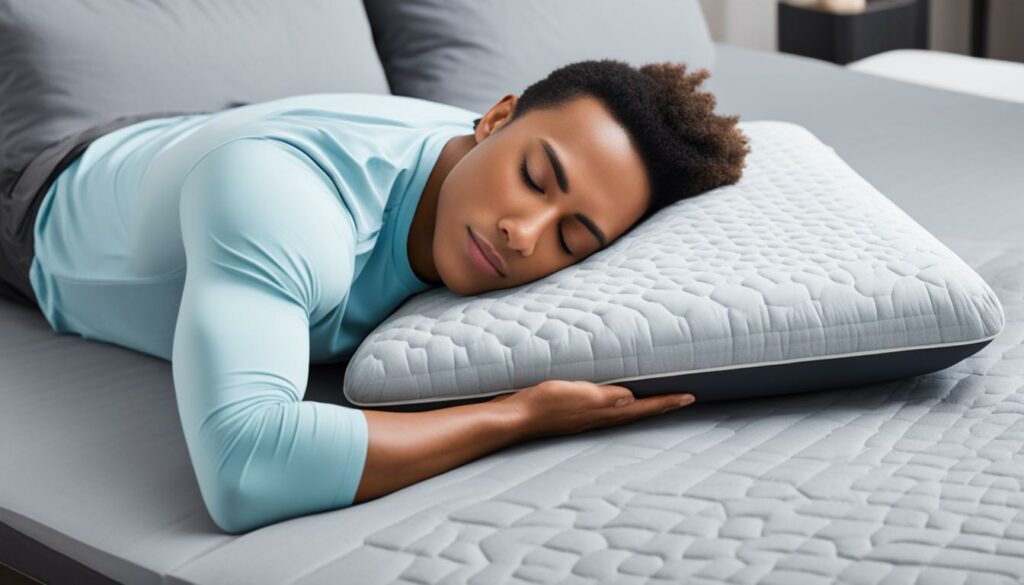
Tips for Choosing the Right Mattress:
- Opt for a medium-firm mattress for the right balance of comfort and support.
- Consider a memory foam mattress topper to improve spine alignment.
- Test out mattresses before purchasing to find the best fit for your lower back.
- Use a plywood board under your mattress if it lacks firmness.
Comparing Different Mattress Types:
| Mattress Type | Comfort Level | Support Level |
|---|---|---|
| Innerspring | Varies (depends on the quality of mattress) | Varies (depends on coil type and density) |
| Memory Foam | Soft to medium-firm | Excellent (contours to the body) |
| Latex | Medium-firm | Excellent (responsive and supportive) |
| Hybrid | Varies (depends on the combination of materials) | Varies (depends on the combination of materials) |
Other Sleep Hygiene Tips
In addition to pillow placement and mattress choice, there are other sleep hygiene tips that can improve your sleep quality and reduce back pain. By incorporating these tips into your bedtime routine, you can enhance your sleep experience and wake up feeling refreshed and pain-free.
Establish a Consistent Sleep Schedule
Setting a regular sleep schedule helps regulate your body’s internal clock, making it easier to fall asleep and wake up at the same time every day. Aim for a consistent bedtime and wake-up time, even on weekends, to establish a healthy sleep-wake cycle.
Avoid Stimulants Before Bed
Caffeine and stimulating activities can interfere with sleep, making it harder to relax and fall asleep. Avoid consuming caffeine in the afternoon and evening, and limit your intake of stimulating activities, such as vigorous exercise and intense screen time, before bed.
TIP: Instead of reaching for a cup of coffee or engaging in stimulating activities, try winding down with a relaxing activity, such as reading a book or taking a warm bath.
Incorporate Relaxation Techniques
Practicing relaxation techniques before bed can help calm your mind and prepare your body for sleep. Deep breathing exercises, progressive muscle relaxation, and meditation are all effective ways to reduce stress and promote relaxation.
Create a Sleep-Friendly Environment
Ensure your bedroom is quiet, dark, and at a comfortable temperature. Use blackout curtains or a sleep mask to block out light, and consider using earplugs or a white noise machine to minimize disruptive noises. Investing in a comfortable mattress, pillows, and bedding can also contribute to a restful sleep environment.
By incorporating these sleep hygiene tips into your routine, along with proper pillow placement and choosing the right pillow and mattress, you can optimize your sleep and alleviate lower back pain for a healthier, more comfortable rest.
Using Body Pillows for Support
Body pillows can be a game-changer when it comes to finding relief from lower back pain. Whether you’re a pregnant woman seeking extra support or an individual experiencing discomfort in your lower back, using a body pillow can provide the additional comfort and alignment you need for a restful night’s sleep.
One effective way to use a body pillow for lower back pain relief is by placing it between your knees when sleeping on your side. This simple positioning technique helps maintain proper spine alignment and reduces pressure on the lower back. By creating a cushioned support system, the body pillow helps alleviate strain on the muscles and allows for a more comfortable and pain-free sleep.
Not only does the body pillow support your lower back, but it also provides a sense of coziness and security, promoting a deeper and more restorative sleep. The softness and contour of a body pillow make it an excellent addition to your sleep routine, especially if you suffer from chronic lower back pain or discomfort.
Here’s a closer look at how a body pillow can help:
- Provides support and comfort
- Maintains proper spine alignment
- Reduces pressure on the lower back
- Promotes better sleep quality
Investing in a high-quality body pillow specifically designed to support the lower back can make a significant difference in your sleep experience. Look for a pillow that offers firm support and is made from hypoallergenic materials for added comfort and convenience.
When it comes to body pillow placement, experiment with different positions and find the one that works best for you. Whether you prefer hugging the pillow or placing it strategically between your knees, listen to your body and choose the method that provides the most relief and comfort.
Harness the power of body pillows and experience the transformational benefits they offer for lower back pain relief. Say goodbye to restless nights and hello to rejuvenating sleep with the support and comfort of a body pillow.
Incorporating Regular Exercise
Regular exercise is an essential component in relieving lower back pain and promoting overall wellness. By strengthening the muscles that support your lower back and improving body mechanics and flexibility, you can experience long-term relief from discomfort and improve your quality of life.
Engaging in exercises that target the core muscles, including those supporting the spine, can be particularly beneficial. By focusing on strengthening your core, you are providing stability and support to your lower back, reducing the strain on the surrounding muscles, and promoting better posture.
Here are some exercises that you can incorporate into your routine to help alleviate lower back pain:
- Planks: Planks are a great way to engage your core muscles and strengthen your abdominal muscles and lower back. Start by resting your forearms on the ground, elbows below your shoulders, and your toes on the floor. Keep your body in a straight line, engaging your core, and hold for 30 seconds to a minute. Repeat for multiple sets.
- Bird Dogs: Start on all fours, with your hands directly beneath your shoulders and your knees beneath your hips. Extend one arm forward while extending the opposite leg backward. Keep your core engaged and your back neutral. Hold for a few seconds, return to the starting position, and repeat on the opposite side. Aim for 10 to 12 repetitions on each side.
- Supermans: Lie facedown on a mat or the floor with your arms extended in front of you. Simultaneously lift your arms, chest, and legs off the ground while keeping your neck neutral and looking down. Hold for a few seconds, then lower back down. Repeat for multiple sets.
- Bridge Pose: Lie on your back with your knees bent and feet flat on the ground, hip-width apart. Slowly lift your hips off the ground, engaging your glutes and core muscles. Hold for a few seconds, then lower back down. Repeat for multiple sets.
Remember to consult with a healthcare professional or a qualified fitness instructor before starting any exercise regimen, especially if you have a pre-existing condition or are experiencing severe pain. They can provide personalized guidance and recommend exercises that are suitable for your specific needs and abilities.
Regular exercise, along with proper pillow placement and sleep posture, can help you find relief from lower back pain and improve your overall well-being. So, get moving and give your lower back the support it needs!
Managing Stress and Maintaining a Healthy Lifestyle
Stress can have a significant impact on muscle tension and exacerbate lower back pain. It’s important to incorporate stress management techniques into your daily routine to promote better sleep quality and alleviate discomfort. One effective method is to practice meditation, which can help calm your mind, relax your muscles, and reduce stress levels. Deep breathing exercises offer another simple yet powerful way to release tension and promote relaxation throughout your body. By controlling your breath and focusing on slow, deep inhales and exhales, you can activate your body’s relaxation response and ease the strain on your lower back.
In addition to stress management, maintaining a healthy lifestyle is key to supporting lower back pain relief. A balanced diet rich in nutrients can provide the essential building blocks for a healthy body, including strong muscles and bones. Incorporating regular physical activity into your routine, such as walking, swimming, or yoga, can help strengthen the muscles that support your lower back and improve overall flexibility. Remember to start slowly and gradually increase the intensity and duration of your workouts to avoid strain or injury.
Furthermore, it’s crucial to pay attention to your sleep environment and use an ergonomic pillow for lower back pain. The right pillow placement can make a significant difference in providing comfort and support to your lower back. Investing in a lower back pain relief pillow, specifically designed to align and support your spine, can help alleviate discomfort and promote better sleep posture. Combine this with proper stress management techniques and a healthy lifestyle, and you’ll be well on your way to finding relief from lower back pain and improving your overall well-being.
Daily Stress Management Tips:
- Practice meditation for a few minutes each day.
- Incorporate deep breathing exercises into your routine.
- Engage in activities that bring you joy and help you relax.
- Set aside time for self-care and prioritize your well-being.
Healthy Lifestyle Tips for Lower Back Pain Relief:
- Eat a balanced diet rich in fruits, vegetables, and lean proteins.
- Stay hydrated by drinking an adequate amount of water each day.
- Engage in regular physical activity to strengthen your muscles.
- Avoid smoking and limit alcohol intake, as they can worsen inflammation and impair healing processes.
Conclusion
Finding the right pillow placement and sleeping position is essential for alleviating lower back pain and achieving a restful night’s sleep. By following the tips and recommendations in this article, you can improve your sleep posture, alleviate discomfort, and promote overall well-being.
Experimenting with different pillow placements can help you identify the most effective position for your specific needs. Whether you sleep on your side, back, or stomach, ensure your spine, pelvis, and hips are properly aligned. Use pillows to provide support, fill any gaps, and maintain the natural curvature of your spine.
Investing in the best pillow for lower back pain is crucial. Look for pillows that cradle your head and neck while supporting the upper portion of your spine. Depending on your sleeping position, consider thin or firmer pillows, or even incorporate body pillows for additional support.
Remember, achieving pain relief and a good night’s sleep is a personal journey. Don’t hesitate to consult with a healthcare professional or physical therapist if you need further assistance in finding the optimal pillow placement, sleeping position, or incorporating exercises into your routine. Prioritize your sleep, prioritize your health.
FAQ
Where should I put a pillow for lower back pain?
If you sleep on your side, place a pillow between your legs to align your spine, pelvis, and hips. If you sleep on your back, put a pillow under your knees to relax your back muscles and maintain the natural curve of your lower back. If you sleep on your stomach, consider placing a pillow under your hips and lower stomach to reduce back strain.
How should I use a pillow for lower back pain?
Side sleepers should put a pillow between their legs for better spine alignment. Back sleepers should place a pillow under their knees and support their neck with a pillow. Stomach sleepers should use the thinnest pillow possible, or no pillow at all, and place a pillow under their hips and lower stomach if necessary.
What is the best pillow for lower back pain relief?
The best pillow for lower back pain will vary depending on your sleeping position and personal preferences. Back sleepers may benefit from thinner pillows with extra padding for neck support. Side sleepers should look for firmer pillows and may consider using a pillow between their knees. Stomach sleepers should use the thinnest pillow possible or no pillow at all.
How important is alignment for lower back pain relief?
Proper alignment of your spine is crucial for relieving lower back pain. Whether you sleep on your side, back, or stomach, focusing on aligning your ears, shoulders, and hips can reduce stress on your muscles and spine. Use pillows to fill any gaps between your body and the bed for better support.
What should I consider when choosing a pillow for lower back pain?
Your pillow should cradle your head and neck while supporting the upper portion of your spine. Back sleepers may benefit from thinner pillows with extra padding for neck support. Side sleepers should look for firmer pillows and consider using a pillow between their knees. Stomach sleepers should use the thinnest pillow possible or no pillow at all.
How does my mattress choice affect lower back pain?
A medium-firm mattress is generally recommended as it provides a balance of comfort and support. Adding a memory foam mattress topper to an existing mattress can also improve spine alignment. Test out a mattress before purchasing, or use a plywood board under your current mattress for added firmness.
What other sleep hygiene tips can help with lower back pain relief?
Establishing a sleep schedule, avoiding caffeine and stimulating activities before bed, and incorporating relaxation techniques can all contribute to a better night’s sleep and reduce back pain.
Can body pillows provide support for lower back pain?
Yes, body pillows can provide additional support and comfort, particularly for pregnant women or individuals with lower back pain. Placing a body pillow between your knees while sleeping on your side can help maintain proper spine alignment and reduce pressure on the lower back.
Can regular exercise help alleviate lower back pain?
Yes, regular exercise is essential for strengthening the muscles that support the lower back and improving overall body mechanics and flexibility. Engaging in exercises that target the core muscles, including those supporting the spine, can help alleviate lower back pain over time.
How can stress management and a healthy lifestyle contribute to lower back pain relief?
Stress can contribute to muscle tension and increased lower back pain. Incorporating stress management techniques, such as meditation and deep breathing exercises, can help reduce muscle tension and promote better sleep quality. Maintaining a healthy lifestyle, including a balanced diet and regular physical activity, can also contribute to lower back pain relief.
Eric Christie stands as a luminary in the bedding industry, with a career spanning nearly four decades since the early 1980s. His journey through the world of bedding has seen him wear many hats – a manufacturer, designer, and retailer, showcasing his versatility and expertise in Read more...



